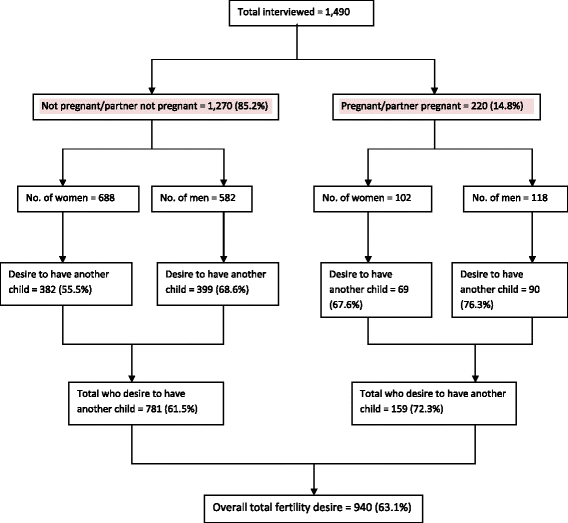Determinants of fertility desire among married or cohabiting individuals in Rakai, Uganda: a cross-sectional study
- PMID: 28069056
- PMCID: PMC5223449
- DOI: 10.1186/s12978-016-0272-3
Determinants of fertility desire among married or cohabiting individuals in Rakai, Uganda: a cross-sectional study
Abstract
Background: Recent trends in fertility rates indicate declines in total fertility rate (TFR) in some sub-Saharan African countries. However, countries such as Uganda continue to have a persistently high TFR partly attributed to strong preferences for large family sizes. We explored the factors that influence fertility desire among married or cohabiting individuals in Rakai, a rural district in southwestern Uganda.
Methods: This cross-sectional study of fertility desire (desire to have another child) was nested in a cluster-randomized demand-creation intervention trial for the promotion of couples' HIV counseling and testing uptake among married or cohabiting individuals that was conducted in Rakai district between March 1 and April 30, 2015. A total of 1490 married or cohabiting individuals, resident in three study regions with differing background HIV prevalence, were enrolled into the study. Data were collected on socio-demographic, behavioral and fertility-related characteristics. We used a modified Poisson regression model to generate prevalence ratio (PR) as a measure of association for factors that were independently associated with fertility desire. We adjusted for clustering at community level and used STATA version 14.0 for all analyses.
Results: Overall, fertility desire was high (63.1%, n = 940); higher in men (69.9%, n = 489) than women (57.1%, n = 451). More than three-quarters (78.8%, n = 1174) had 3+ biological children while slightly more than two-thirds (68.5%, n = 1020) reported an ideal family size of 5+ children. Only 30% (n = 452) reported that they had attained their desired family size. After adjusting for potential and suspected confounders, the factors that were negatively associated with fertility desire were: age 30-39 (adjusted prevalence ratio [aPR] = 0.82, 95% CI: 0.78, 0.86) and 40+ years (aPR = 0.65, 95% CI: 0.60, 0.71); having six or more biological children (aPR = 0.88, 95% CI: 0.80, 0.97); being HIV-positive (aPR = 0.86, 95% CI: 0.78, 0.95) and ever use of any family planning methods (aPR = 0.93, 95% CI: 0.87, 0.99). Being male (aPR = 1.19, 95% CI: 1.07, 1.33); having primary education (aPR = 1.21, 95% CI: 1.01, 1.44) and having not yet attained the desired family size (aPR = 4.34, 95% CI: 3.50, 5.38) were positively associated with fertility desire.
Conclusion: Having not yet attained one's desired family size, being male and having primary education were positively associated with fertility desire in this population. Targeting individuals who have not yet attained their desired family size, men and less educated individuals with fertility regulation interventions may help to reduce fertility desire in this population.
Keywords: Determinants; Fertility desire; Married individuals; Rakai; Uganda.
Similar articles
-
Correlates of previous couples' HIV counseling and testing uptake among married individuals in three HIV prevalence strata in Rakai, Uganda.Glob Health Action. 2015 Jun 8;8:27935. doi: 10.3402/gha.v8.27935. eCollection 2015. Glob Health Action. 2015. PMID: 26058858 Free PMC article.
-
Evaluation of a demand-creation intervention for couples' HIV testing services among married or cohabiting individuals in Rakai, Uganda: a cluster-randomized intervention trial.BMC Infect Dis. 2016 Aug 8;16:379. doi: 10.1186/s12879-016-1720-y. BMC Infect Dis. 2016. PMID: 27502776 Free PMC article. Clinical Trial.
-
Risk factors for HIV infection among married couples in Rakai, Uganda: a cross-sectional study.BMC Infect Dis. 2020 Mar 6;20(1):198. doi: 10.1186/s12879-020-4924-0. BMC Infect Dis. 2020. PMID: 32138696 Free PMC article.
-
Traditional supports and contemporary disrupters of high fertility desires in sub-Saharan Africa: a scoping review.Reprod Health. 2023 Jun 6;20(1):86. doi: 10.1186/s12978-023-01627-7. Reprod Health. 2023. PMID: 37280648 Free PMC article.
-
What is the relationship between increased access to HAART, relationship status and fertility decisions amongst HIV-positive women? A literature review and meta-analysis.J Clin Nurs. 2017 Dec;26(23-24):3800-3810. doi: 10.1111/jocn.13731. Epub 2017 Mar 22. J Clin Nurs. 2017. PMID: 28102939 Review.
Cited by
-
Modern contraceptive utilization and associated factors among reproductive-age women in Ethiopia: evidence from 2016 Ethiopia demographic and health survey.BMC Womens Health. 2020 Mar 26;20(1):61. doi: 10.1186/s12905-020-00923-9. BMC Womens Health. 2020. PMID: 32216823 Free PMC article.
-
Socio-economic and demographic factors associated with fertility preferences among women of reproductive age in Ghana: evidence from the 2014 Demographic and Health Survey.Reprod Health. 2021 Jan 2;18(1):2. doi: 10.1186/s12978-020-01057-9. Reprod Health. 2021. PMID: 33388063 Free PMC article.
-
Prevalence and factors associated with fertility desire among HIV-positive women in Rwanda in the context of improved life expectancy.Arch Public Health. 2021 Nov 25;79(1):209. doi: 10.1186/s13690-021-00742-w. Arch Public Health. 2021. PMID: 34819164 Free PMC article.
-
Changes in Providers' Self-Efficacy and Intentions to Provide Safer Conception Counseling Over 24 Months.AIDS Behav. 2018 Sep;22(9):2895-2905. doi: 10.1007/s10461-018-2049-x. AIDS Behav. 2018. PMID: 29464428 Free PMC article.
-
Fertility desires of antiretroviral therapy-attending HIV-positive women and its associated factors in Harari region, Ethiopia.Int Health. 2024 Mar 4;16(2):174-181. doi: 10.1093/inthealth/ihad030. Int Health. 2024. PMID: 37128936 Free PMC article.
References
-
- United Nations, Department of Economic and Social Affairs, Population Division. Fertility levels and trends as assessed in the 2012 revision of World Population Prospects. United Nations; 2013. http://www.un.org/en/development/desa/population/publications/pdf/fertil.... Accessed 7 July 2016.
-
- Shapiro D, Gebreselassie T. Fertility transition in sub-Saharan Africa: falling and stalling. Afr Popul Stud. 2008;23(1):3–23.
-
- Lesthaeghe R. The fertility transition in sub-Saharan Africa into the 21st Century: Population Studies Center Research Report 14–823. 2014.
MeSH terms
LinkOut - more resources
Full Text Sources
Other Literature Sources
Medical
Research Materials
Miscellaneous


